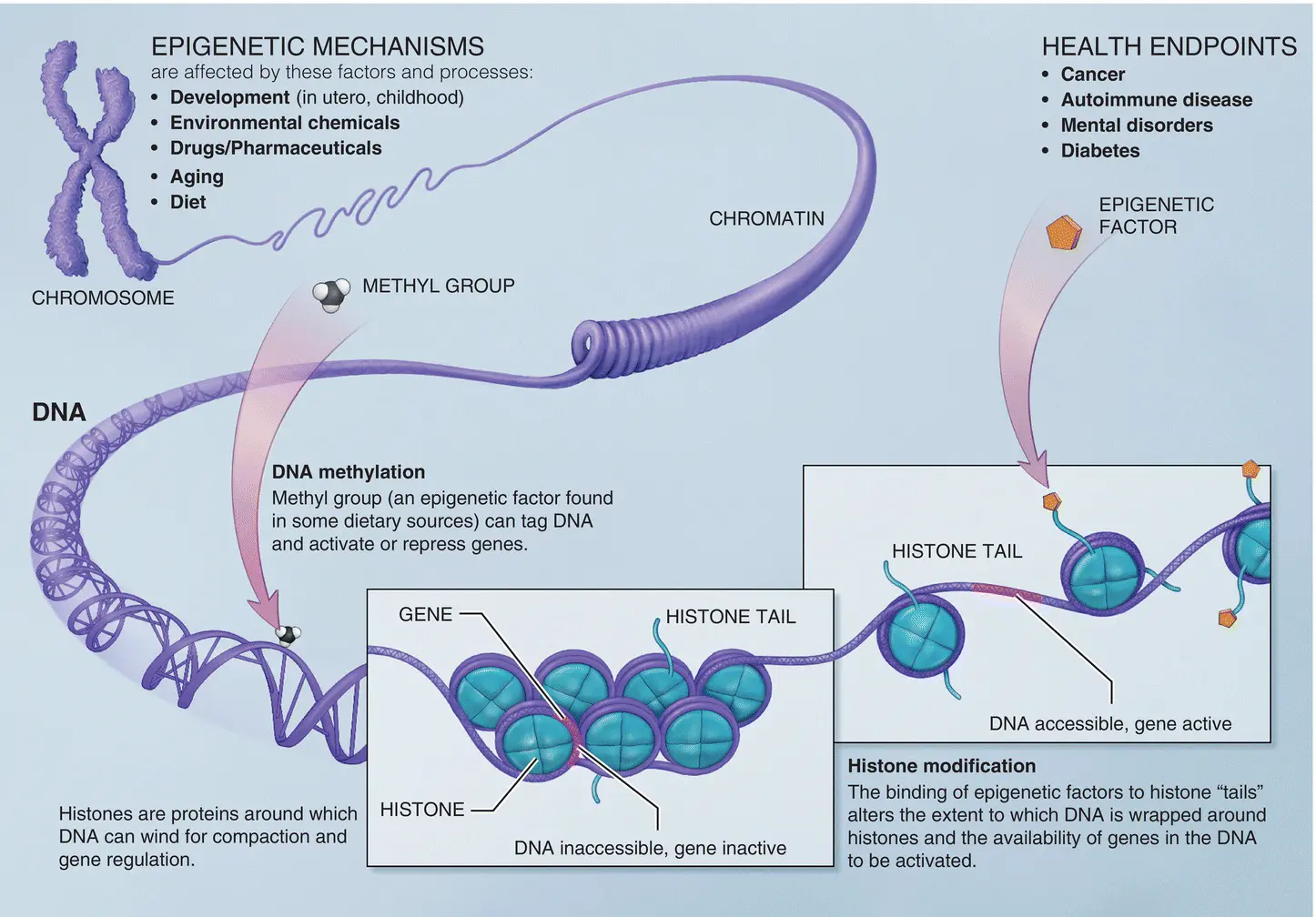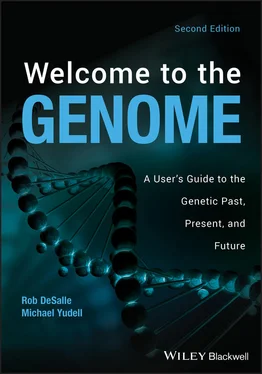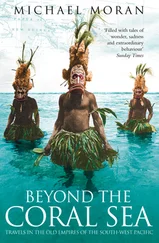Researchers were able to examine the methylation patterns of the DNA in an important gene called insulin‐like growth factor II (IGF2) of women who suffered through the Dutch Hunger Winter. Six decades after the famine, women exposed to it had much less methylation of IGF2 than women who escaped the famine. The implication of the study is that early mammalian development is an incredibly important stage where DNA sequences are highly prone to methylation tags as a result of some environmental shock like famine. Such methylation alters the gene expression of important genes involved in many phenotypes. More importantly, these methylation patterns can persist for long periods of time.
The Dutch Hunger Winter case is only one of many where epigenetic factors like DNA methylation and histone modification have an impact on human health. Epigenetic factors are also important in other organisms and have been implicated in many evolutionary phenomena. (83)

Figure 1.12The mechanisms of epigenetics.
Credit: National Institutes of Health
1 1. The Encode Project Consortium. 2012. “An Integrated Encyclopedia of DNA Elements in the Human Genome,” Nature 489: pp.57–74.
2 2. S. Anderson et al. 1981. “Sequence and Organization of the Human Mitochondrial Genome,” Nature 290: pp.457–465; https://www.mitomap.org/MITOMAP; Iakes Ezkurdia et al. 2014. “Multiple Evidence Strands Suggest That There May Be As FewAs 19,000 Human Protein‐Coding Genes,” Human Molecular Genetics 23: pp.5866–5878.
3 3. Kip A. West et al. 2003. “Rapid Akt Activation by Nicotine and a Tobacco Carcinogen Modulates the Phenotype of Normal Human Airway Epithelial Cells,” Journal of Clinical Investigation 111: pp.81–90; Kristine Novak. 2003. “Double Whammy,” Nature Reviews Cancer 3: p.83.
4 4. Peter J. Bowler. 1989. The Mendelian Revolution: The Emergence of Hereditarian Concepts in Modern Science and Society. Baltimore, MA: The Johns Hopkins University Press.
5 5. Euripides, Electra, as quoted in Conway Zirkle. 1951. “The Knowledge of Heredity Before 1900,” Genetics in the Twentieth‐Century: Essays on the Progress of Genetics During Its First 50 Years. L.C. Dunn ed. New York: The MacMillan Company, p.42.
6 6. Hans Stubbe. 1972. History of Genetics: From Prehistoric Times to the Rediscovery of Mendel’s Laws. Cambridge, MA: The MIT Press, pp.51–52.
7 7. Stubbe, 1972, pp.1–6.
8 8. Stubbe, 1972, p.33.
9 9. Ernst Mayr. 1982. The Growth of Biological Thought: Diversity, Evolution, and Inheritance. Cambridge, MA: The Belknap Press of the Harvard University Press, pp. 636–637; Ernst Mayr. 1988. Toward a New Philosophy of Biology: Observations of an Evolutionist. Cambridge, MA: The Belknap Press of Harvard University Press.
10 10. Stephen Jay Gould. 1977. Ontogeny and Phylogeny. Cambridge, MA: The Belknap Press of the Harvard University Press, pp.19–20.
11 11. Staffan Müller‐Wille and Hans‐Jorg Rheinberger. 2007. “Heredity—The Formation of an Epistemic Space,” in: Heredity Produced: At the Crossroads of Biology, Politics, and Culture, 1500–1870. Staffan Müller‐Wille et al. (eds). Cambridge, MA: MIT Press, pp.3–34.
12 12. Müller‐Wille and Rheinberger, 2007, p.12.
13 13. Müller‐Wille and Rheinberger, 2007, p.12.
14 14. Viterslav Orel. 1984. Mendel. New York: Oxford University Press, pp.19–23.
15 15. Robin Marantz Henig. 2000. The Monk in the Garden: The Lost and Found Genius of Gregor Mendel, the Father of Genetics. New York: A Mariner Book, pp.21–22.
16 16. Orel, 1984, pp.28–33.
17 17. Mayr, 1982, p.725.
18 18. Henig, 2000, pp.69–93.
19 19. Henig, 2000, p.86.
20 20. Henig, 2000, pp.85–86.
21 21. D. Peter Snustad and Michael J. Simmons. 2003. Principles of Genetics. New York: John Wiley & Sons, p.55.
22 22. Henig, 2000, p.140.
23 23. Orel, 1984, p.51.
24 24. Henig, 2000, p.140.
25 25. Henig, 2000, p.79.
26 26. Orel, 1984, p.92.
27 27. Ulf Lagerkvist. 1998. DNA Pioneers and Their Legacy. New Haven, CT: Yale University Press, pp.101–102.
28 28. Orel, 1984, p.93.
29 29. Bowler, 1989, p.3; Adrian Desmond. 1997. Huxley: From Devil’s Disciple to Evolution’s High Priest. Reading, MA: Addison‐Wesley.
30 30. Mayr, 2002, p.727.
31 31. Bowler, 1989, pp.108–116.
32 32. Garland E. Allen. 1978. Thomas Hunt Morgan: The Man and His Science. Princeton, NJ: Princeton University Press, p.165.
33 33. L.C. Dunn. 1965. A Short History of Genetics: The Development of Some of the Main Lines of Thought: 1864–1939. New York: McGraw‐Hill Book Company, pp.xvii, xxi.
34 34. Allen, 1978, p.149.
35 35. Allen, 1978, pp.150–153.
36 36. Donald Pierce et al. 1996. “Studies of the Mortality of Atomic Bomb Survivors, Report 12, Part 1. Cancer: 1950–1990,” Radiation Research 146: pp.1–27; A.M. Kellerer. 2000. “Risk Estimates for Radiation‐Induced Cancer—The Epidemiological Evidence,” Radiation and Environmental Biophysics 39: pp.17–24.
37 37. Neil A. Campbell. 1999. Biology. New York: Addison Wesley Longman, Inc., p.359.
38 38. Allen, 1978, p.172.
39 39. Allen, 1978, pp.173–179.
40 40. Allen, 1978, pp.175–176.
41 41. Allen, 1978, p.164.
42 42. Allen, 1978, pp.173–179.
43 43. Daniel J. Kevles. 1995. In the Name of Eugenics: Genetics and the Uses of Human Heredity. Cambridge, MA: Harvard University Press, pp.3–19.
44 44. Francis Galton. 1883. Inquiries into Human Faculty and its Development. London: J.M. Dent, p.17.
45 45. Joe William TrotterJr. 1991. The Great Migration in Historical Perspective: New Dimensions of Race, Class, and Gender. Bloomington, IN: Indiana University Press; Nicolas Lemann. 1992. The Promised Land: The Great Black Migration and How it Changed America. New York: Vintage Books; Matthew Jacobson. 1998. Whiteness of a Different Color: European Immigrants and the Alchemy of Race. Cambridge, MA: Harvard University Press.
46 46. Charles B. Davenport. 1923. Eugenics, Genetics, and the Family: Volume 1, Scientific Papers of the Second International Congress of Eugenics, Baltimore, MD: Williams & Wilkins Company, p.4.
47 47. Allen, 1978, p.232.
48 48. William H. Tucker. 1994. The Science and Politics of Racial Research. Urbana, IL: University of Illinois Press, p.95; Kevles, 1995, pp.102–103.
49 49. Celeste Michelle Condit. 1999. The Meanings of the Gene: Public Debates About Human Heredity. Madison, WI: University of Wisconsin Press, p.27; Alexandra Minna Stern, Eugenic Nation: Faults and Frontiers of Better Breeding in Modern America. Berkeley, CA: University of California Press, 2005, p.254; Adam Cohen. 2016. Imbeciles: The Supreme Court, American Eugenics, and the Sterilization of Carrie Buck. New York: Penguin Press.
50 50. Elof Axel Carlson. 2001. The Unfit: A History of a Bad Idea. Cold Spring Harbor, New York: Cold Spring Harbor Laboratory Press, p.12.
51 51. Paul Popenoe and Rosewill Hill Johnson. 1933. Applied Eugenics. New York: MacMillan, p.141.
52 52. Kevles, 1995, p.46; Josefson, Deborah. 2002. “Oregon’s Governor Apologises for Forced Sterilisations,” BMJ 325, no. 7377: p.1380.
53 53. William Provine. 1986. “Genetics and Race,” American Zoologist 26: pp.857–887.
54 54. As quoted in Provine, 1986, p.868.
55 55. Michael Yudell. 2014. Race Unmasked: Biology and Race in the Twentieth Century. New York: Columbia University Press.
56 56. Madison Grant. 1916. The Passing of the Great Race: The Racial Bias of European History. New York: Charles Scribner and Sons, p.45.
Читать дальше













